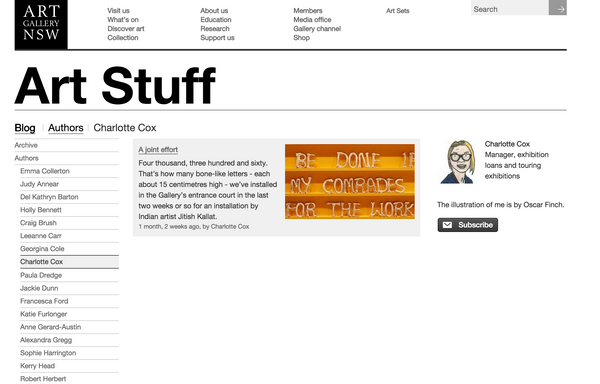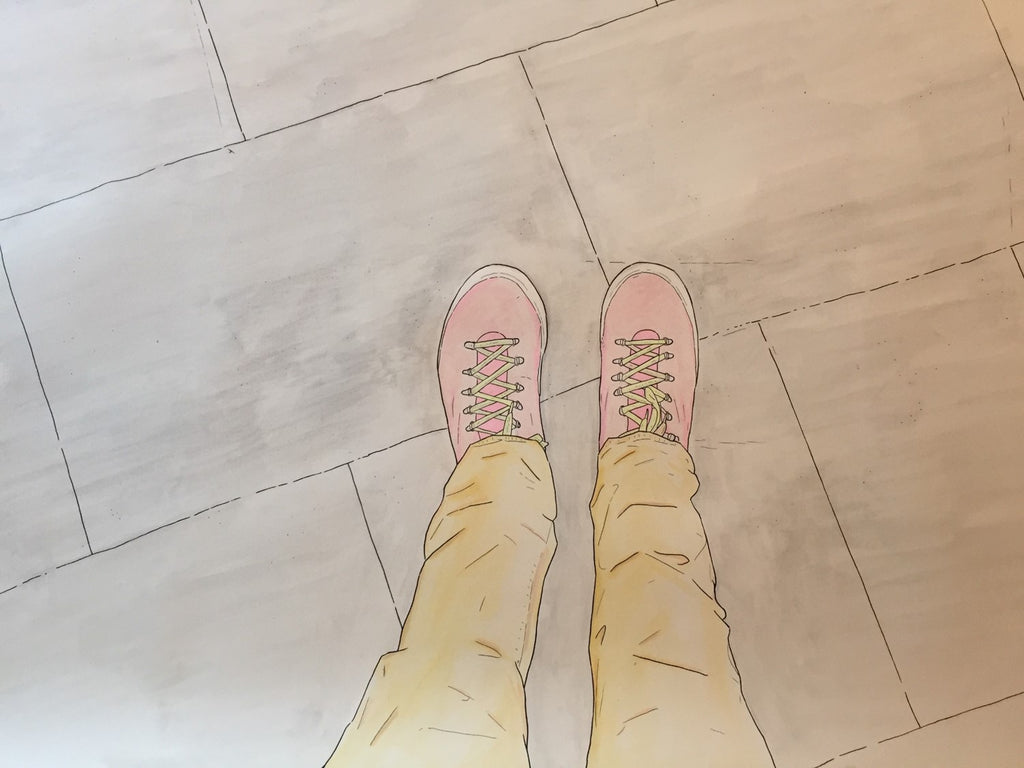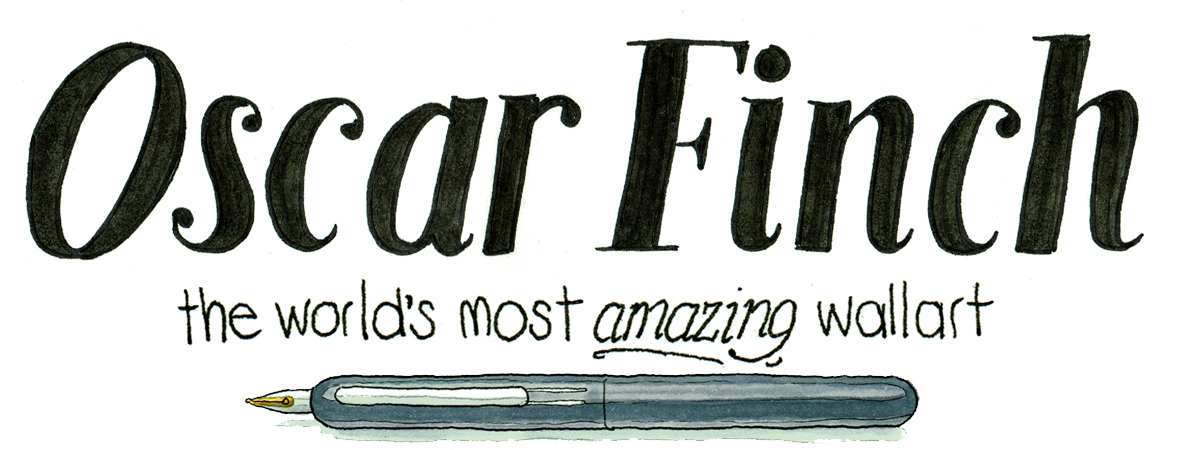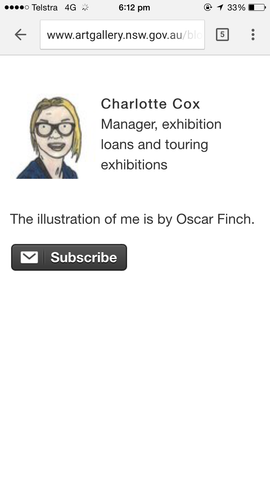What I learnt trying to win the Archibald Prize last year (and how it’s going to help me - or maybe you - win)
Hello there friend.
If we’ve not met, my name is Oscar Finch. I’m an artist who hides in plain sight to capture unnoticed strangers and objects then imagines their tales.
Last year I shared my quest ‘How to Win the Archibald Prize’.

I would have won but for the judges picking someone else. But there was a secret I'd been keeping: the Archibald Prize isn't really a prize. It's a raison d'être - a reason for being - each year for the 900 or so artists who enter.
What was my master plan to win? I analysed all previous winners to identify common traits and gaps to be a pioneer (oil on a rectangle canvas is common, as too is an artist as subject, likewise impressionist styling).
What did I learn from my 85 day odyssey and how will it help me win this year? A few things.
- Standing out amongst the swath of 900 artworks is vital. You could stand out by drawing a hairy green chicken but standing out for a good reason is more helpful. Without standing out you’re an autumn leaf tramped underfoot.
- If you’re no Monet or Picasso don’t try to out-paint someone who is. You’ll need another weapon so...
- Have a big, bold breathtakingly idea that screams.
- The Archibald is an art prize in the art world for the art world. As I swanned around the Archibald Prize opening last year I realised the obvious. It’s an inner circle so to win you need to find a way into the inner circle (and therefore the judges).
- What this means is you don't need a million people to care about your artwork maybe just one or two or three.
- Frame your artwork (unless it’s as tall as the ceiling). It might be little realised but a frame is kind of a shibboleth that you’re part of the inner artworld circle.
- Have a plan for your artwork when you don’t win (something more useful than a room divider or garage filler). On the flip side use the Prize as an excuse to do something you always wanted to (meet your pop culture hero by painting them or yell a message to the world). Here’s the secret: everyone who does this is a winner before the winner is announced.
- Finish your work with a week to spare (unless your liked midnight study cramming as a high schooler).
I'm going to do all of these things and a few more. And I have until 24th June to do them and I'll be sharing my journey. I've called it:

Wish me luck.
Oscar
P.S - I'd love to send you my updates, just go here.
You can see my Archibald Journey here and my other creations and art here.
Answers to the #6 common questions about my Archibald journey
Well, as my ‘How to win the Archibald Prize’ journey ends for 2015 I wanted to answer the #6 most common questions from readers. Here they are...
If you had only one minute to explain your ‘How to win the Archibald Prize' journey, how would you do it?
I would use this picture and scribbling below!



How did you fare? If you think the Archibald Prize is an art prize, everyone lost except Nigel Milsom. If it’s not (which it isn’t) then I won. My explanation is here.
What do you look like? Would Batman show what he really looks like?
What’s next? At the opening of the Archibald I realised it was mostly poor artists painting in the hopes of rich, immaculately beautiful (and sartorially eccentric) people noticing their works in a giant building with white walls. It’s a wonderful and curious world, but next I’ll do the very opposite. If you’d like to follow that next radical journey just subscribe to my newsletter (I’d love to share with you!).
More immediately, I was issued a challenge for the Moran Prize….I met Artist Samuel Condon at the Archibald opening recently (killer portrait of John Jarratt) and last week he issued me with a challenge to enter the Doug Moran National Portrait Prize with my rebellious style-flavour.
I counter-challenged Samuel with a radical suggestion to collaborate by spending no more than 60 minutes each.
With my 60 minutes I created a happily yellow-suited Samuel staring dramatically below (you can see all the details here).
I would love him to now replicate my piece in his masterful oil on canvas way but limiting himself to a rapid 60 minutes (you'd be amazed what you can do in 60 minutes, really - Adele wrote 'Skyfall' in under an hour, likewise Taylor Swift with 'We are never getting back together' in 2012) .
Busy artist and student he is (Masters of Curatorship etc.) he was hesitant. Let's encourage him to collaborate with me to give the art world something relatably off-kilter...
Can I buy your A to Z of the Archibald? Boy, I’d love that immeasurably (subscribe to my newsletter and I’ll let you know when it is ready!)
What did you do before this whole Archibald thing? I sit in plain sight in Sydney (possibly New York, Tokyo, Melbourne, Adelaide, Dunedoon) and draw unnoticed people and imagine their stories. Here is some of my stuff although I’ve another fifty I’m finishing as we speak.
Thanks for sharing my life for the past few months, here’s to the next chapter!
Kindly, Oscar
If I’d won the 2015 Archibald Prize: A drawing of an alternate history

Although the Archibald Prize is not an art prize but a raison d’etre for artists there is a single exception. That exception is the artist showered with glory, etched in history and $100,000 wealthier when the judges declare the winner.
This year it was a portrait of Charles Waterstreet by Nigel Milsom. And as I gazed at this imposing oil on linen at last Friday’s opening night I imagined how that painting might have looked had I painted it (and in turn, had Nigel Milsom painted mine). That's the image above.

(Think blacker ink, more vibrant colours on my side and alternatively jagged, geometric shapes and shades of grey on Nigel’s).
If you know Nigel, why not ask him to imagine my alternative history and illustrate it?
I'm pleased to announce that while you probably can't own the winning Archibald painting, you can own an original print of my illustration above (which is surely the next best thing!). Just go here.
My final post on this Archibald journey will bring everything together in an extravagant summation. Look out for it...
Dear Judges of the Archibald Prize, Love Oscar (and all entrants)
Dear Judges of the Archibald Prize,
I hope you don't mind that I'm writing?
It's just that I know as a three time entrant that the Archibald Prize is sometimes a mystery surrounded by a labyrinth in an unfamiliar maze and I'd like your help. Of course, judging is a difficult job, after all there are nearly 900 works that are mostly oils of unfamiliar faces varying in quality. It can’t be easy.
That’s why this year I tried to make your job a little easier by using the maverick materials of paper and ink (gigantic paper in one case and a gigantically wide Japanese Album notebook in the other - more on that in a second).
You may even have read my words (the Japanese Album 'A to Z of the Archibald').
If you recall my works I succeeded in a small way by being noticeable.
If not, please accept for apologies for failing to captivate you.
I’m writing with a simple request that I’d be ever so grateful if you can help with.
I couldn't help but notice you didn't select me as a finalist this year. That's okay, truly (after all, winning at a contest isn't always the point). I wonder if you might shed some light on what you thought of my paintings?
It would be so helpful for next time.
(After all sometimes for any artist it can feel like we’re Dorothy and judges are the Wizard of Oz behind a great big curtain).
Perhaps I could be so bold as to go a small step further and ask you to imagine something.
Van Gogh and Monet for example were both well acquainted with rejection in their lifetime but acclaimed later. Of course, its not a fair comparison but imagine if my work were to be recognised and praised in 10 or 20 or 50 years, I wonder what you think might be said?
I’ve drawn an imaginary book from the future called 'Australia's Greatest Art' below, written a few sentences (see Sidney Nolan on the left for an example and myself on the right) with blank spaces to make it easier for your simple words of encouragement (it’s my way of clinging onto hope - the great fuel of any artist’s endurance).

Thank you taking the time to hear from me.
Kindly, Oscar
P.S - If you’re a judge I'd love for you to email me. If you know a judge I’d be ever so grateful if you could get this letter to them!
Here is a list of the judges:
Mr Guido Belgiorno-Nettis
Mr Mark Nelson
Mr Geoff Ainsworth
Mr Khadim Ali
Mrs Ashley Dawson-Damer
Professor S Bruce Dowton
Ms Samantha Meers
Ms Gretel Packer
Mr Ben Quilty
Mr Andrew Roberts
Ms Eleonora Triguboff
When losing is not losing (and actually winning) the Archibald Prize
You probably weren’t aware, but I'm listed as an artist on the Art Gallery Of NSW website. Truly. Here it is...

How did that happen? I'll tell you in a moment.
Firstly, late last week finalists for the 2015 Archibald Prize were announced and they featured the glaring omission of a certain gigantic piece of paper masterpiece. I was grateful for the many kind commiserations but there is the secret I've been keeping. The Archibald isn't really a prize (so I didn't really lose). It's a rede d'être - a reason for being - for a few months each year for the 900 or so artists who enter.
The snare is that to most it’s an art prize (which means all but one will lose year after year).
And contests have a mysterious life of their own: Bob Dylan lost out to a tap dancing act in his high school talent contest and folklore has it that Charlie Chaplin was a distant runner-up in a Charlie Chaplin contest.
My first Archibald entry was as a 19 year old which taught me this enduring truth. So when I delivered my entry last year I took note of the unnoticed hero of the Archibald Prize, Charlotte, without whom entries could not have been taken and therefore awarding a prize impossible. I wrote a heartfelt thanks and sent it to her which unforeseen and unknown to me until recently led to my name being listed on the Art Gallery Of NSW website.
(And that you're reading this tale means I’ve already gained something special - a momentary occupation of your mind!).
I started this odyssey 3 months ago with this question: How can I to win the Archibald Prize? Truth is that the judges don’t announce the winner. Like the tap dancer who defeated Bob Dylan at the high school talent contest, she thought she’d won so too will this year's $100,000 prize winner. But it’s what Bob Dylan did next that determined the real winner.
Likewise, it’s what I do next. Keep watching (I’ve plans afoot as you read, so wish me luck).
(Here is Charlotte...and a closer look at the Art Gallery Of NSW website).

The complete series 'How to win the Archibald Prize'
Sign up for my newsletter to follow my adventures here (and for your chance to win my original art on a t-shirt or original print)
P.S - If you'd like an original print of my Archibald journey for $20 just go here.
How I tried to win the Archibald Prize as a radical rebel (and what I learnt along the way)

85 days ago I started something I didn’t quite understand.
How can I win the Archibald Portrait Prize? That's the question I asked myself and my small band of followers. I’m now tantalisingly close to an answer.
But before I go there, let me start at the beginning.
When I was 19 I entered the Archibald Portrait Prize for the very first time. It was my way of trying to assure the smallish country boy I was that maybe I could do something bigger than my town. Of course Adam Cullen won that year and my work sank without a trace. But it birthed in me hope.
It wasn’t until last year that I returned to the scene of my failure with a sequel which placed in the top 884 works (there were 884 entries). Wood Allen once said '80 percent of life is showing up', and that was my philosophy.
But this year I was determined to do more. To win.
To answer the question ‘How can I win the Archibald Portrait Prize?’ I started with a little history of the Archibald, its ebbs and flows.
The Archibald prize is the most famous art award in the Australian art world, founded in 1921 and given to ‘the best portrait of a man or woman distinguished in art, letters, science or politics in the previous year’. But its ways are mysterious. Like a furious tempest that dances to its own tune, who wins the Archibald prize and how they win seemed like a maze surrounded by a labyrinth within a giant puzzle.
So I tried to make sense of it by examining common traits of the previous Archibald winners - materials, size, subject, colours and style (most commonly a large oil painting of an artist with realist or expressionist style).
But of course there have been rule-breakers that changed history. William Dobell in 1943 won with a famous caricature that broke convention. Brett Whiteley in 1976 shocked with his self-portrait (a reflection in a hand mirror in his studio surrounded by personal objects).
Of course I had to decide which approach to take - conventional wisdom, rebel or radical rebel? My audience decided on radical rebel so I charted what a radically rebellious winner for the Archibald Prize might be and came up with this diagram.
But grabbing the judge’s attention as they sweep past over 800 other hopefuls is the first hurdle to winning. So on two counts I had to stand out and be recognised. The first is to paint someone recognisable to the judges and the second is to use size and shape. Artists are the most common subject of winners (over a third), and a sportsman, banker and journalist the least (only once). In recent years 3.5 metres is the standard surface area of a winner and portrait dimensions are the most popular shape and canvas the most popular surface. This is the context I need to stand out in.
Now, I’m no Old Master which presented a challenge to using oil paints on canvas in a realist style but of course if you want to beat a strongman you can’t do it with strength. Instead you need to outwit him.
So instead I chose to use what made me distinctive, like Picasso did it with cubes, Damien Hirst did it with formaldehyde and a tigershark and Tracey Emin did it with an unmade bed. That is I decided to approach the Archibald Prize as I would my other art - with simple black ink, vibrant colours of the vast unnoticed parts of Sydney and imagination.
This led me to 5 radical ideas each with intriguing strengths and 19 days to create one.
I chose the landscape of George Street in which to put my subject using a giant 3.3 metre tall watercolour paper and here’s why.
It's large - gargantuan actually - (the limit is 3.4 metre high because that’s as tall as the walls of the Art Gallery of NSW). Its proportions are unusual because it's relatively narrow (1.4 metres wide). It tells of the vast expansive city we live in but don't often notice and uses bright colours and blankets of white space. It’s ink, watercolour on paper (which has never won before) and tucked as a small life amongst the dominating scene is artist Peter Drew who has been travelling around Australia to 8 cities with his 'Real Australians Say Welcome' campaign. Here is my full explanation and pictures of my final painting.
In 85 days I’ve learnt a lot.
I learnt that self-doubt is a familiar acquaintance but will visit less when ignored. And while failing is scary, success is almost as scary but doing nothing is the scariest.
I learnt that hidden inside everyone is an artist because almost everyone has suggestions about how I should paint the Archibald Prize differently - a different subject, different medium, different size, different style. Everyone should do it at least once!
I’ve learnt it’s hard involving others in my ideas because it feels like sending my child to a hungry lion pride. But it’s more interesting and rewarding, kind of like watching a movie with someone rather than alone.
Will I win (and change art history)? Maybe. If not, like Thomas Edison did with the light bulb, I’d have learnt one more way not to win the Archibald Prize which puts me one step closer next year.
The complete series 'How to win the Archibald Prize'
Sign up for my newsletter to follow my adventures here (and for your chance to win my original art on a t-shirt or original print)
P.S - If you'd like an original print of my Archibald journey for $20 just go here.
My Archibald Prize entry in pictures (and why I painted on a piece of paper the height of an Art Gallery of NSW wall)
Almost three months ago I began a quest to win the Archibald Prize. No easy feat so I needed to do some thinking and sharing and to hear collective wisdom (thank you world).
I'd entered twice before without winning so wanted to understand what made a winner. I analysed all the previous winners to find some patterns to the mystery (think a giant oil painting of an artist in vibrant expressionist or realist style). But of course there have also been rogues that flipped the Archibald on its head like William Dobell in 1943 and Brett Whiteley in 1976.
Those rebels had a different take on what had come before but enough winning traits to capture the judge's imagination with a freshly different angle.
With the help of my audience and my inner inclination to go a little rogue I approached my entry this year as a ‘radical rebel’.
But what would a radical rebel look like? Turns out it wouldn't use oil nor canvas (convenient because of course I’m no Old Master). What it might do is use watercolours and ink (rarely won).
This was fortuitous because I would certainly not want to try and beat masters of oil portraits with an oil portrait - that is, don’t try and beat a strongman with strength. I had to approach my piece with what makes my stuff distinctive (think simple black ink lines, the usually unnoticed, a cityscape and vibrant colours).
But of course to win one must first stand out (last year I saw the vast swamp of hundreds of canvases that looked like a scene from the novel '1984'). So I resolved to avoid canvas. Of course, paper is my constant companion but being noticed would require something else. So I decided on a gigantic piece of paper the edge of the size limit (limit of 3.3 metres high given the art gallery walls are 3.4 metres).
But what to paint and how?
I needed a subject that resonated to keep me going in the lonely early hours of the morning as I tried to fill the gigantic paper. I’d previously seen and reacquainted myself with a certain artist who did just that. His series ‘Art vs Reality’ was tonic to my mind and sugar to my imagination. Likewise his most recent odyssey ‘Real Australians Say Welcome’ was a poignant message told in a compellingly different way where he travelled to 8 cities across Australia putting giant street posters with a simple, beautiful message (ideally just out of reach of council cleaners).
His name? Peter Drew.
(Here are my notes from our first conversation which felt like speaking to a more articulate, suaver version of myself in a parallel universe).

But Peter is an artist competing with the giant world and a sometimes lonely message.
George Street is one of the busiest and most famous streets in Sydney with the Queen Victoria statue and building. It’s also a regular haunt of mine that brings together the most diverse set of people you can imagine. But it’s also one of the loneliest for eye contact with almost everything remarkable going unnoticed.
I wanted to tell of the bigness of the city and the smallness of an artist trying to change it.
What I’ve also noticed is that artworks with small details draws an audience and the eye in, capturing precious time and attention.
Those are my feet in the foreground to put the audience into the picture (pink to symbolise the radical rebel). The stretching buildings to the sky recall Immanual Kant’s observation ‘Two things fill the mind with ever new and increasing admiration and awe, the starry heavens above me and the moral law within me’.
Now that it's complete, I wait...
Here is the expansive bird's eye shot... with all the detailed photos below.

Queen Victoria Building...

View from the Queen Victoria Building down...

The centre...

Town Hall and Queen Victoria's face...

Peter at work...

Peter in his glorious smallness...

Bottom looking up...

My radical rebel shoes...(and you in the picture)

The complete series 'How to win the Archibald Prize'
Sign up for my newsletter to follow my adventures here (and for your chance to win my original art on a t-shirt or original print)
P.S - If you'd like an original print of my Archibald journey for $20 just go here.







